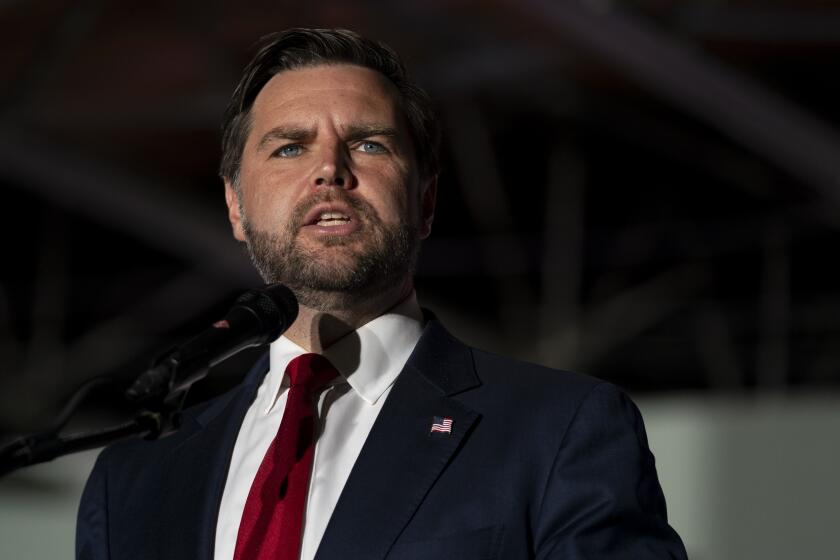Proposals would cut benefits for California employees 25% to 40%
Reporting from Sacramento — Pension benefits for hundreds of thousands of state workers would be reduced 25% to 40% under two proposals that have become the focal points for what could become a costly and bruising ballot fight over retirement funding.
In a new financial analysis estimating the cutbacks, the nonprofit California Foundation for Fiscal Responsibility warned that rising costs of public employee pensions and retiree healthcare could overwhelm the ability of taxpayers to fund many basic health, welfare and public safety services.
“Public employees are getting far more benefits than those in the private sector,” said Marcia Fritz, the foundation’s president, adding that voters are “fed up.”
“The upshot,” she said, “is going to be a huge fight” — an initiative contest that will be followed closely nationwide.
According to the study, to be released Thursday, California’s five biggest pension funds are in precarious financial conditions. Last year, they had only enough money to cover 61% to 74% of their obligations to current employees.
Without a significant scaling back, “public employer obligations for retirement benefits will rise sharply over the next decade, further squeezing government budgets that are already facing enormous pressures,” the study said.
The proposals, the primary efforts statewide to curtail public pension benefits, have prompted labor unions to dispatch so-called truth squads to the state Capitol this week to debunk warnings that the cost of public pensions would saddle future California generations with billions of dollars in debt.
Teachers, police officers and retirees are telling lawmakers that state workers already have made pension reduction concessions and get only modest benefits.
Critics of public pensions “selectively draw attention to headlines about the few sensational cases of abuse,” said Martha Penry, a special education teacher in Sacramento. “They continue to spread myths and falsehoods about public employee pensions.”
The foundation’s research focused on proposals that would reduce payouts by about 40% for workers currently on the state payroll and by one-fourth for people hired after 2011.
Benefits for members of the California State Teachers’ Retirement System wouldn’t be significantly changed by the proposed overhaul, the study concluded. Teacher pension benefits already are lower than those received by most state workers.
The first proposal is modeled on the federal government’s retirement system and recently was endorsed in concept by the state’s Little Hoover Commission, a nonpartisan panel that studies ways to make government function more efficiently.
The second, a version of 401(k) plans widely used by private sector employers, is expected to be the basis for a proposed initiative that may be submitted to the Secretary of State this month. Backers hope to gather enough signatures to put the measure before voters on the June 2012 ballot.
Lawmakers, meanwhile, have been engaging in contentious debates over the ratification of new state employees’ union contracts, Republican efforts to limit pension benefits and the governor’s still vague promise to include pension reform in an overall deal to fill a $15-billion hole in the state budget.
The study’s cost and saving estimates, as well as a calculator to see how the proposals might work for the state’s 131 public retirement systems, should provide voters and policymakers with much needed information as a possible initiative campaign takes shape, said Dan Pellissier, president of California Pension Reform, the group seeking to qualify a pension reform initiative.
Seven in 10 people said they supported a cap on pensions for current and future public employers, according to a Times/USC Dornsife College poll last month.
Nearly as many, 68%, approved of raising the amount of money government workers should be required to contribute to their retirement, and 52% supported raising the retirement age for government workers.
The looming battle is really about a bigger issue, countered Steven Maviglio, a spokesman for Californians for Health Care and Retirement Security, a union-backed activist group.
“Pension reform is a Trojan horse for an attack on public employees,” Maviglio said. “The agenda is to defund and demoralize public employees and also weaken the union political cause. We’ve seen that in Ohio, Indiana and Wisconsin.”
Benefits now are two to three times larger than those offered by major private sector employers, the Capitol Matrix study said.
The proposed hybrid plan backed by the Little Hoover Commission offers a small fixed monthly payment plus a 401(k)-type savings plan with a limited employer match and Social Security benefits. It also contains a reduction in healthcare benefits for early retirees.
The other proposal caps employer matching contributions at 9% of salary and provides an additional benefit to teachers, who are not eligible for Social Security now.
Pellissier said his nascent initiative campaign committee is leaning toward the latter solution “because it goes to the heart of the problem, which is the cost of benefits.” His initiative would allow benefits for existing employees to be changed when pension systems are significantly underfunded.
Passing a statewide pension overhaul initiative that applies the same rules to behemoths such as the 1.6 million-member California Public Employees’ Retirement System and smaller city and county retirement funds is bound to create unintended consequences, said Teresa Ghilarducci, an economist at the New School of Social Research in New York.
“If pension reform in California is in the form of one size fits all, it won’t be a good reform,” said Ghilarducci, an expert in social insurance programs.
Changes are best negotiated at the local and union level because if “they are too inflexible, they won’t be responsive to the employers’ or the employees’ needs in the context of local labor markets,” Ghilarducci said.
A number of state employee unions, including the Service Employees International Union and the California Assn. of Highway Patrolmen, already have made significant concessions at contract bargaining tables, including reining in some benefits and raising retirement ages, said David Low, director of government relations for the California School Employees Assn.
But, if pension overhaul advocates put “something extreme on the ballot, they will have a fight on their hands and have a good chance of losing,” Low warned.
“The public wants some pension reform,” he said, “but it doesn’t support wiping out people’s pensions.”
More to Read
Inside the business of entertainment
The Wide Shot brings you news, analysis and insights on everything from streaming wars to production — and what it all means for the future.
You may occasionally receive promotional content from the Los Angeles Times.











